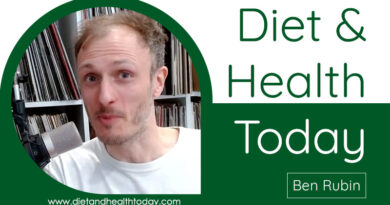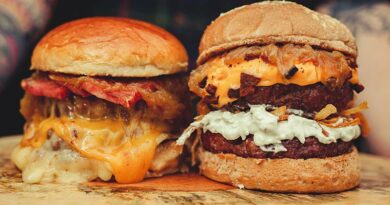Food Groups
There must be something about the number five and public health dietary advice. First the myth of five-a-day, then five times a week (that’s the exercise nonsense) and now five food groups.
UK
The role model plate for healthy eating in the UK – the ‘eatwell’ plate – (or the eatbadly plate, as I call it) informs us that there are five food groups (my notes in blue):
– Fruit and vegetables; (fruit and vegetables are so different, they should never appear in the same category together)
– Bread, rice, potatoes, pasta and other starchy foods; (should be called “things that make you fat”)
– Milk and dairy foods; (milk is a dairy food, duh!)
– Foods and drinks high in fat and/or sugar; (this is not a food group; it’s a description and of two polar opposites) and
– Meat, fish, eggs, beans and other non-dairy sources of protein. (everything other than pure fats & sucrose contain protein, so virtually every non-dairy food falls into this category).
US
The US My Plate also thinks that there are five food groups – just different ones:
– Fruit;
– Veg;
– Grains;
– Protein; and
– Dairy.
My note – protein is a macro nutrient, not a food group. The other four food groups all contain protein (and fat and carbohydrate – just to list all three macro nutrients). This is ignorant in the extreme. I’ve dissected it here.
Australia
Australian children are also taught by Healthy kids Australia that there are five food groups – different ones again:
– Dairy;
– Fruit;
– Grain (cereal foods);
– Lean meats and poultry, fish, eggs, tofu, nuts and seeds; and
– Vegetables, legumes and beans.
My note – this is slightly better in that it doesn’t confuse a macro nutrient with a food group. However, lumping the most nutritious foods into one group and specifying lean meats is bad advice.
Food groups
There is no definitive list of food groups, so I’ll propose one:
– Meat;
– Fish;
– Eggs;
– Dairy;
– Vegetables;
– Fruit;
– Nuts & seeds;
– Legumes (beans, pulses, etc); and
– Grains.
That would make nine groups.
Meat could further break down into red meat, game, poultry. Fish could be categorised as oily fish, white fish, seafood. Starchy vegetables (potatoes, root vegetables) could be set aside from green leafy vegetables and so on. However, as basic food groups go, the nine work well.
As for fats: butter comes under dairy products; lard and meat juices are by-products of (cooking) meat; and oils can be derived from fruit (avocado, olive), seeds (sesame, sunflower), legumes (peanut), or nuts (coconut) etc and hence haven’t been assigned to a separate category.
Dieticians seem to get quite exercised about cutting out whole food groups (notwithstanding food groups having been wrongly defined). They don’t seem to mind when vegetarians cut out meat and fish or even when vegans cut out meat, fish, eggs and dairy. However, they don’t like people cutting out starchy foods – the things that make us fat.
Most people should be OK including some foods from all food groups. Some people (of Asian origin especially) have lactose intolerance and are well advised to avoid dairy.
The most nutritious food groups to choose from are meat/fish/eggs/vegetables/seeds and dairy if you are OK with it. We can get every nutrient we need from meat, fish, eggs, vegetables and seeds. We have no need for fruit, legumes and grains, although they can make enjoyable and versatile additions to our diet, if we can tolerate a higher level of carbohydrate.
There is some debate as to how ‘real’ some of these nine food groups are – dairy and grains are relatively recent additions to our diet. As a general rule, the longer we have been eating something (animals), the more natural/real it is as a food source.
I have yet to meet a human being who benefits from eating wheat (see Wheat Belly and Grain Brain to discover why), but wheat isn’t a food group – it’s one grain and there are better grain choices if you do eat grains, such as brown rice, natural oats, quinoa etc.
Note that sucrose is not in a food group anywhere – nor is much of the cr@p on the UK eatbadly plate – sugary cereal, cola, cakes, biscuits, baked beans, white bagels, chocolate, fruit in syrup, soya drink etc.
My dietary advice
My three key messages are:
1) Eat real food!
Every food from the nine food groups should be eaten in its most natural form – meat with the skin/fat on; whole vegetables, not juice; whole fruits, not dried fruit or juice; brown rice, not white refined etc.
2) Three times a day.
That’s an ideal maximum – if two meals work for you, fine. If your lifestyle demands four, OK. But, unless you are a cow, or want to be the size of one – STOP GRAZING!
3) Manage carb intake.
If (1) and (2) don’t get you to natural weight and optimal health, manage your carb intake. If you are diabetic or very obese, manage your carb intake from the outset. The Harcombe Diet® gets people into the habit of having ‘fat’ meals (based on meat/fish/eggs/dairy) or ‘carb’ meals (based on legumes, grains, starchy veg, fruit). Non starchy veg can be eaten with any meal. Have no more than 1, possibly 0, carb meals a day if very carb sensitive/insulin resistant/diabetic/very obese (Note below).
I hope that this helps to provide a better definition of food groups and far more concise and effective dietary advice than you’ll get from the millions of pages of public health documents and non-science (aka nonsense).
(Note: diabetics should work with their doctors before making any dietary changes. A good doctor will work with a patient to reduce carbs and meds.)




I get all my health advice from two sources, Zoe Harcombe and T-nation website.
Only problem is, every now and then they contradict each other!
Here they say white rice is better than brown;
https://www.t-nation.com/diet-fat-loss/perfect-carb-for-lifters
Hi Oliver – there are two sides to this one!
Brown rice has more nutrients and fibre (if you care about fibre – read this if you do! https://www.gutsense.org/fibermenace/about_fm.html). However T-nation is right about phytic acid and thus the additional nutrients may be compromised anyway.
White rice is less abrasive on the gut (because of the lack of fibre). There are arguments about which leaves you feeling fuller – neither beats a steak!
Personally I prefer the taste of brown rice but I eat rice so rarely I’m hardly a good consumer!
Hope this helps you stick with both of us ;-)
Best wishes – Zoe
This paragraph is my favorite and begs a question I’d like to see dieticians actually answer: “Dieticians seem to get quite exercised about cutting out whole food groups (notwithstanding food groups having been wrongly defined). They don’t seem to mind when vegetarians cut out meat and fish or even when vegans cut out meat, fish, eggs and dairy. However, they don’t like people cutting out starchy foods – the things that make us fat.”
Thanks for all you do, Zoe :)
Hi Tee Dee
I am a dietitian, I have worked in a few specialist areas including eating disorders, respiratory disease and have now spent 3 years working with type 2 diabetes. I don’t like any restrictive diet and the majority of dietitians I know feel the same, the vegan or plant based diet in my opinion is terrible and a large number of anorexics did place themselves under this banner as a good excuse to eat very little.
I am a huge fan of Zoe, Gary Fettke, Tim Noakes and others out there working hard to dismiss the awful guidelines we currently have to follow. I see my current role as advising my patients or client group as best I can without losing my licence to practice, but I can promise you one thing, carbohydrates and sugars are not on my promotional list, having a person go into remission after suffering with insulin resistance or type 2 diabetes is the best reward I have ever had professionally. I hope this gives you some faith that we are aware of the mistakes previously made and taught in our universities, and the way we should be going.
Pingback: Sorta struggling. | Fitter at Fortyish
Confusing advice. Cheddar cheese is 34% fat yet is a dairy food, so it falls into two categories. What is the concerned citizen meant to make of this?
Dumbasses have revised the Aussie “Food Pyramid” yet again, just shuffled fruit/veg to the base to abdicate the almighty grain to Right Hand, with “lean meat” being something you can eat now and then along with tofu and soy.
Nutrition Australia even replied to me on Twitter about it, what a joke they are, but sadly they define what’s “healthy”.
https://twitter.com/CarnivoresCreed/status/604929654659510272
Deeming ~70% of what you MUST eat is stuff you don’t actually need to and probably shouldn’t? Fanbloodytastic job guys, top research I’m sure.
“Stop Grazing!” Love it! I’m going to make that my mantra.
I’ve spent my adult life counting calories & staying low fat & struggled with weight issues the whole time.
I found it very hard to shed weight & was often so hungry I couldn’t sleep.
7 months ago I started my LCHF lifestyle. I haven’t been hungry NOT EVEN ONCE! & I’ve lost 12kg (26lbs).
Am in this for life now as it’s so easy to eat real natural wholesome foods!
The new Aussie Pyramid revision has legumes at the base and again with “Proteins”. Vegan activist alert! Pyramid food schemes have little bearing on what the consumer is faced with at the supermarket. Dietary advice should be individualised. Insulin resistance should be explained to help the obese understand what made the majority of them fat!
Not too sure about the ‘meat with skin on’ – chicken, yes; pork, to a crackling degree; but beef? lamb?
Ha ha – skin/fat – I’ll be specific :-)